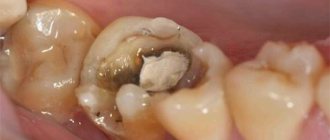Macroglossia - causes of tongue enlargement and consequences of the anomaly
From time immemorial, language has served as the main indicator of human health. Any changes in its appearance and structure, the appearance of plaque and neoplasms are all direct signals that some pathological processes are occurring in the body. One of the most serious phenomena is considered to be an increase in the size of the main speaking organ. This condition is medically called macroglossia. Further in this material we will talk about what it is, why such an anomaly occurs in adults and children, what methods are used today to treat the pathology.
What is a pathological phenomenon?
Macroglossia or enlarged tongue syndrome can be regarded as an anomaly in the development of an organ or a pathological deformation of its shape due to a certain disease. The tongue becomes denser, may partially or completely increase in size and even protrude outside the mouth if it no longer fits inside. Certain changes occur in the structure of the organ, due to which its surface becomes covered with numerous folds and becomes rough. All this leads to severe discomfort, the inability to fully chew food and breathe freely.
Enlarged tongue syndrome
Causes of macroglossia
Most often, the cause of the development of anomalies is congenital pathologies. Thus, the cause of the problem in newborns may be a benign neoplasm that began to grow at the stage of intrauterine development of the fetus, or an idiopathic disease with muscular hypertrophy of the tongue. Other possible prerequisites, dental experts include, are negative influences and conditions during pregnancy, acute infections, radiation exposure, alcohol poisoning, and hereditary factors. Experts also identify a number of genetic disorders, including the formation of cysts in the oral cavity during the formation of the tongue muscles1.
Read more about childhood tongue diseases in our special article>>>
“By the way, I also had no idea about this disease until a work colleague encountered something similar. As far as I understand, something went wrong during pregnancy, and the child was diagnosed with a congenital cyst on the tongue. I had to undergo surgery, and rehabilitation was not easy. It seems like everything is fine with the baby now...”
Kim7, Izhevsk, from correspondence on the woman.ru forum
As for adult patients, in this case macroglossia can result from the following phenomena and processes:
- malfunction of the thyroid gland, hormonal disorders,
- absence of all teeth in the mouth - complete edentia,
- open bite,
- amyloidosis – a disorder of protein metabolism,
- glycogenosis – disorders of the synthesis and breakdown of glycogen,
- pellagra is one of the forms of vitamin deficiency,
- rhinoscleroma – formation of nodules on the mucous membrane of the oral cavity and nasopharynx,
- syphilis, tuberculosis,
- neoplasms of both benign and malignant nature,
- inflammatory processes accompanied by the formation of pus,
- angioedema in acute form,
- “flaccid” tongue syndrome, characteristic of neurological disorders,
- intramuscular hemorrhage,
- candidiasis (fungal infections),
- malfunctions of the hematopoietic system,
- catarrhal glossitis.
There can be many causes of the pathology.
Sometimes a severe allergic reaction can provoke the problem. Also in medical practice, there are cases when the patient’s overweight becomes a prerequisite for pathology.
Annika Irmler
Now Annika Irmler's , a tongue 7 centimeters long, has long been broken, but back in 2001 it was an undoubted leader. During the competition, it was necessary to pull the muscle out of the mouth as far as possible, which was achieved by a 12-year-old girl.
Of course, this feature gained Annika fame and popularity at school. And even before that, as a child, she demonstrated an unusual organ to everyone who asked.
Characteristic symptoms
In order to respond to a problem in a timely manner, you need to know what signs to recognize it. Here are the main symptoms of macroglossia:
- enlarged tongue, to the point where the organ no longer fits in the oral cavity,
- dryness of mucous membranes,
- difficulty breathing, asthma attacks,
- difficulty chewing and swallowing food,
- lumpy surface of the tongue
- enlarged taste buds
- excessive salivation,
- inability to close your mouth normally,
- formation of bleeding cracks on the back,
- diction problems,
- often an increase in temperature, the addition of common infections.
With this pathology, it is impossible to close the mouth normally.
Gradually, the patient’s condition worsens, the bite is deformed, and ulcers appear on the back of the organ. The area around the mouth becomes inflamed and irritation occurs.
Chanel Tapper
The American also became a record holder in the Book of Records (the length of her tongue was 9.75 centimeters ). The girl noticed the peculiarity at the age of 8, when she was photographed with her mother on a holiday. Then she noted that her tongue was visually 2 times longer than her mother’s.
Subsequently, the peculiarity was noticed by her classmates, to whom Chanel Tapper gladly demonstrated various tricks. She calmly reaches her elbow and nose with her tongue, and also goes below her chin. The girl admits that she no longer has any complexes about the unusual length of the organ and is proud of her achievements.
How is macroglossia treated today?
The treatment method is selected taking into account the reasons that led to the increase in the size of the tongue. The doctor also takes into account all the changes that have occurred during the development of the disease. In the event that macroglossia is the result of some systemic disease, the root cause of the disease is treated first.
Drug therapy
We already said above that the problem may be the result of an infectious infection. In this case, specialists usually prescribe drug therapy aimed at eliminating the causative factor. As a rule, these are antibiotics, drugs that help normalize metabolic processes, restore the functioning of blood and lymphatic vessels, and agents that stimulate tissue regeneration. Special medications may also be prescribed to treat the surface of the tongue and oral mucosa in order to relieve swelling and inflammation.
If the cause of the pathology is an infection, then antibiotics are prescribed
Surgery
When the situation becomes more serious, surgery may be required. Typically, the surgical method is used to correct a birth defect, immediately after the birth of a child. There are several methods of such treatment:
- resection of the affected organ area,
- phlebectomy or sclerotherapy - usually performed when the cause of the disease is malfunction of the blood vessels. When performing a phlebectomy, the doctor removes damaged vessels, and in the second, he injects a special drug that stimulates the restoration of their functionality,
- blocking the lingual artery - this method is usually used when a child needs treatment at the stage of active growth. In this way, it is possible to minimize the supply of hormones, and the size of the tongue begins to return to normal,
- trimming the frenulum - the organ is raised to maximum tension, after which the frenulum is shortened to 1.5 cm. An advantage is the fact that the operation does not require sutures.
In some cases, surgical intervention is required.
The optimal treatment option is an integrated approach to treatment. The fastest and highest quality results can be achieved by combining drug therapy and surgical treatment.
Tongue tube
4. The ability to curl your tongue is not genetic.
In 1940, American geneticist Alfred Sturtevant suggested that the ability to roll the tongue into a tube is the work of dominant genes (that is, strong ones). And that only those people whose parents also have this ability can roll their tongue into a tube.
However, in the 1950s. in a study of 33 pairs of twins, this was not confirmed in seven cases: one of the twins could do it, and the other did not. It must be said that this misconception is very popular even now - some teachers use it to explain the essence of the inheritance of genetic characteristics. However, there is no scientific basis for this phenomenon, so it is a myth.
5. The tongue is not the strongest muscle
The strongest human muscle is not the tongue, as many claim. Firstly, the tongue is a muscle that consists of 16 muscles, and secondly, it is called the strongest, implying the power of the word.
By the way, the strongest muscle, in terms of the force generated, is the masticatory muscle; on human molars it develops a force of up to 72 kg. The strongest stretching muscle is the calf muscle; it can support weight up to 130 kg. If someone remembers the heart, then the heart is the most resilient muscle.
What could be the consequences if treatment is not started on time?
Macroglossia is not just an aesthetic defect, but a serious pathological phenomenon that can lead to dangerous consequences. Among the possible negative developments, dental experts highlight the following phenomena:
- serious disruptions in the functioning of the lungs, frequent cases of asphyxia, which in the worst circumstances can even lead to death,
- the formation of malocclusion in children, which also negatively affects the condition of the body as a whole,
- disturbances in the functioning of the gastrointestinal tract, since with such a pathology it is quite difficult to chew food thoroughly,
- deformation of teeth and soft tissues of the oral cavity,
- speech dysfunction and problems with the patient’s social adaptation.
Frequent biting of the organ, the appearance of cracks and microtraumas cannot be avoided - all this causes serious inconvenience and can provoke the development of an infectious process. It is important to respond to the problem in a timely manner in order to prevent possible complications.
- Matveev, PC Clinical system for diagnosing macroglossia, 2013.
How to detect pathology
Doctors distinguish between false and true macroglossitis. The first is due to the abnormal structure of the jaw apparatus. At the same time, the jaw is narrow and slightly sunken, but this is not evidence of a real disease, it is the result of an abnormal structure of the bone apparatus and tissues.
When the true form of the disease develops, the tongue is too large, its volume is several times higher than normal. In addition, additional symptoms are:
- inability to completely close the mouth, the organ is stuck out;
- increased production of salivary fluid, there is a lot of it in the mouth, it flows out or drips;
- irritation and redness of the skin under the lower lip and on the chin;
- imprints from the teeth are visible on the surface of the organ, it can also become covered with ulcers or erosions;
- presence of malocclusion;
- Difficulty eating – difficulty chewing and swallowing;
- difficulty speaking.










